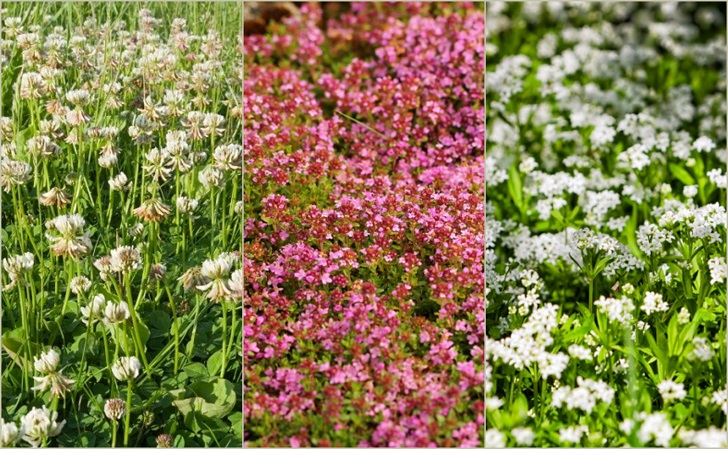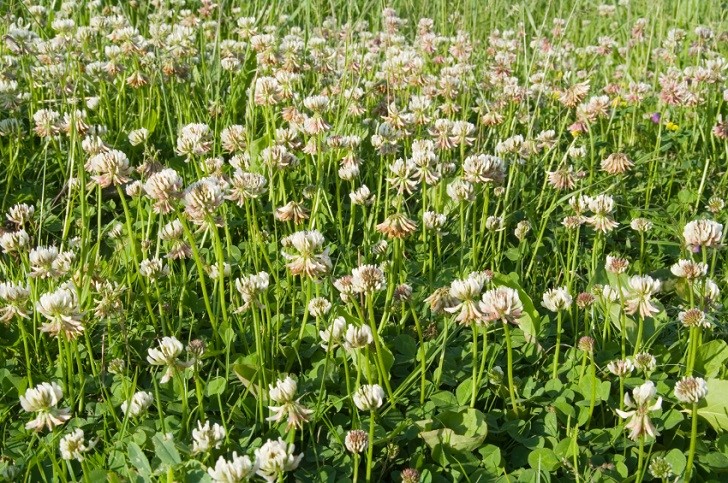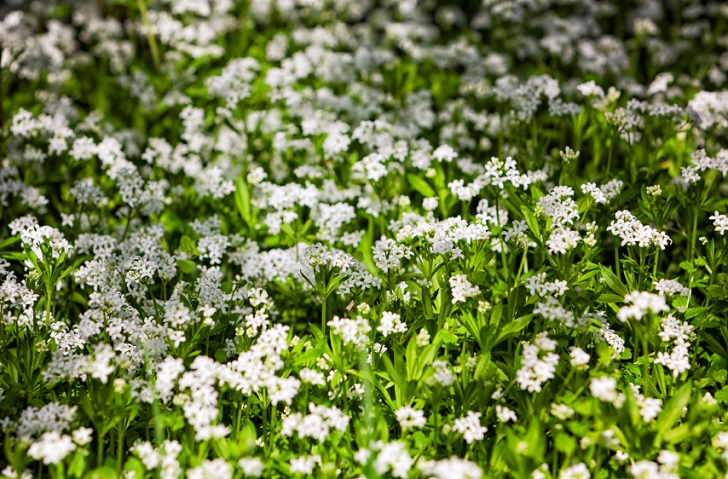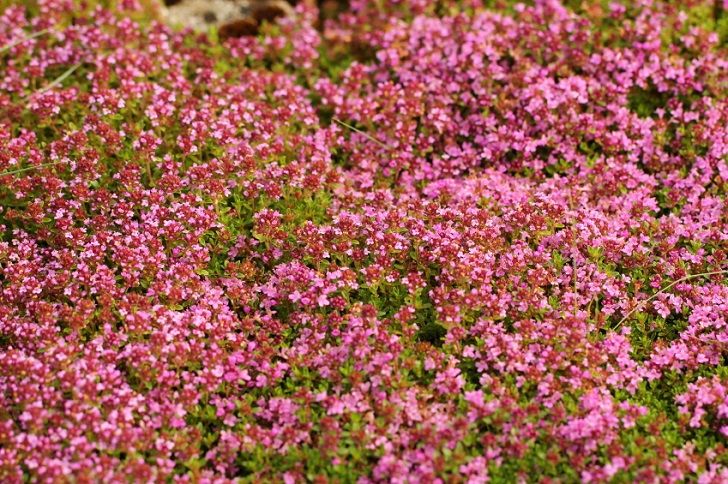
A lush lawn is the dream for most homeowners, a uniform emerald carpet that covers up unsightly dirt and provides a soft space to walk and play. But popular turf grasses – like Kentucky bluegrass and Ryegrass – are time-consuming, resource-intensive, and expensive to maintain. They need regular mowing, watering, and fertilizing. They need to be overseeded, aerated, and top-dressed. They need pesticides and herbicides to appear healthy, which carries its own risks to your health and the environment. And despite all your hard work, you may still encounter thatch and dead zones.
If you’re rethinking the wisdom of growing lawn grass, there are lots of alternatives out there that will certainly lessen the chore of keeping traditional turf grass – while encouraging more biodiversity, reducing the use of chemicals and water, and provide an interesting and unusual groundcover that will actually allow you to enjoy your summer weekends!
1. English Chamomile (Chamaemelum nobile ‘Treneague)
Harkening back to the 15th century when ground covers were more reminiscent of meadows than grasses, chamomile was a popular choice among European aristocrats. A low-lying creeper, the non-flowering C. nobile ‘Treneague’ variety is ideal for lawns since it only rarely needs to be trimmed. Providing a thick mat of fern-like foliage, English chamomile can handle light or occasional foot traffic and it releases a pleasant apple scent when crushed underfoot.
2. Corsican Mint (Mentha requienii)
A creeping member of the mint family, Corsican mint forms a solid spread of tiny round leaves that reach a height of less than an inch. It adapts well to sun or shade, but should be kept in moist areas to maintain its light green hue. Emitting a minty aroma when walked upon, it is better planted in spots where foot traffic is only occasional.
3. Sedge (Carex spp.)
With over 2,000 varieties of sedge, many of which grow natively all over the United States, it’s not too hard to match the right cultivar for the growing conditions in your region. Producing clumping mounds that look a lot like grass, you can have a lawn that looks just like a lawn while eschewing mowing, watering, and fertilizing all together. Able to withstand the occasional trampling, some recommended lawn replacement varieties include Baltimore sedge, California Meadow Sedge, and Pennsylvania sedge.
4. White Clover (Trifolium repens)

While some may consider the lowly white clover plant to be just another invasive weed, it is actually quite the wonder worker when it comes to carpeting your landscape. Quickly spreading while crowding out other weeds, the root system of the white clover has the amazing ability to convert nitrogen into fertilizer, thereby reducing the need for additional soil amendments. Producing little orbs in cream or pink, these simple flowers are quite attractive to bees and butterflies. White clover is able to withstand low to moderate pedestrian activity, and it thrives equally well in both sun and shade, as well as in dry or poorly-drained soil.
5. Prairie Meadows
If you do, in fact, want a natural meadow instead of turf, then a mix of perennial wildflowers, low-growing grasses, and native ornamental plants may just be the solution. Providing food and shelter for local wildlife as well, natural meadows will add some much-needed biodiversity to the standard lawn’s expansive monoculture. While you can purchase an assortment of wildflower seed mixes, it’s always a good idea to contact your county extension office first to determine which plants are native to your region.
6. Dwarf Mondo Grass (Ophiopogon japonicus ‘Nanus’)
Forming tight deep green grassy clumps, dwarf mondo grass is an excellent ground cover that grows just 2 inches tall. Flourishing in both sun and shade, it is quite durable and will still look great after repeated footfalls.
7. Sweet Woodruff (Galium odoratum)

With star-shaped foliage and delicate vanilla-scented white flowers, sweet woodruff is a hardy little herb that is best planted in moist and shaded areas. There’s no need to fertilize sweet woodruff and supplemental watering should only be done during times of reduced rainfall or drought. It will grow to a height of 8 to 10 inches, so occasional mowing is needed if you don’t want the natural meadow look in your yard.
8. Sheet Moss (Hypnum cupressiforme)
Needing a moist, shady environment, moss is a non-vascular plant that receives water and nutrients through their fuzzy green foliage. In lieu of roots, mosses have delicate rhizoids that anchor them to soil, rocks, and tree trunks. Akin to fungus, sheet moss reproduces via spores. There’s no need to mow or fertilize moss – it will simply go dormant during cold or dry bouts and quickly spring back to life once growing conditions are suitable again, even after many years. Sheet moss is somewhat fragile but can tolerate occasional foot traffic.
9. Blue Star Creeper (Isotoma fluviatilis)
An easy-going plant, blue star creeper is perfectly happy in all soil types and is totally fine with full sun, some sun, or complete shade, and can handle heavy treading. Displaying small rounded leaves and light blue flowers that appear in spring, it forms a dense mat that reaches only 3 inches in height.
10. Stonecrop (Sedum spp.)
Well-suited for arid environments, stonecrops are succulent plants that require very little water to survive. There are over 600 varieties of stonecrop, and most are low-growing and easy to care for, featuring tall flower spikes that attract bees, butterflies, and moths. Often the choice of plant for green roofs because they are so hardy, recommended cultivars for a lawn substitute include S. album, S. acre, and S. floriferum.
11. Creeping Thyme (Thymus serpyllum, Thymus praecox)

Incredibly drought resistant and requiring way less water than the traditional lawn, creeping thyme is a dwarf shrub that offers a bit of fragrance and color for your open spaces. Many creeping thyme cultivars make for great lawn replacements – ‘Pink Chintz’, ‘Elfin’, ‘Coccineus’, and ‘Woolly’ are just a few of the options – with floral hues that range from reds and pinks to purples and whites. Depending on the variety, creeping thyme can tolerate moderate to heavy foot traffic.
12. Fogfruit (Phyla nodiflora)
Native to California, fogfruit is a robust perennial that can handle heavy use – it’s even able to withstand the rambunctiousness of children and pets. Growing between 1 to 4 inches tall, fogfruit features grey-green oblong leaves and pink flowers that bloom from spring to autumn.
